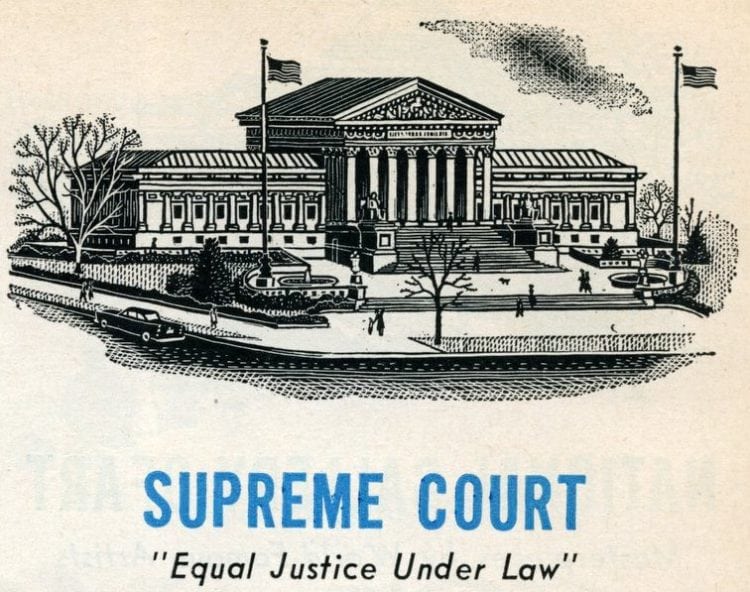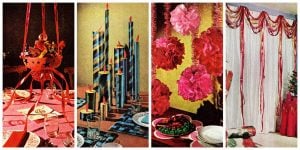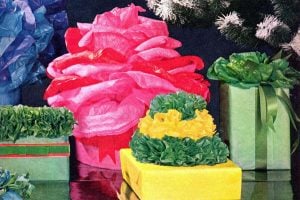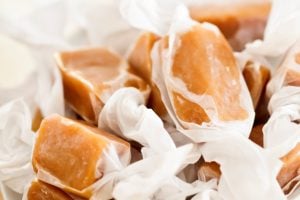Sightseeing in Washington DC: A Woman’s Day Pocket Guidebook from the 1950s
Highlighting: The Capitol • Supreme Court • National Gallery of Art • Smithsonian Institution Washington Monument • Bureau of Engraving and Printing • Jefferson Memorial • Lincoln Memorial • White House • Department of Justice • Arlington National Cemetery • Mount Vernon

Two days in Washington DC: Your guide (1956)
A cutout guidebook to make and carry with you during 2 days in Washington
A family tour, prepared by Bernard DeVoto / Note: Picture postcards are from the 1940s
Washington DC, the center of our government, is full of the symbols — and indeed the very landmarks — of the dangers, travail, achievements, hopes, and fears that the American people experienced while they were making us the nation we now are.
These strike sparks in every parent visiting the city with his family, and he hopes his children too will kindle with the same awareness of American power, of the richness and greatness and variety of the national life, of the memories and continuing experience that bind the present to the past, of a deep belief in the future.
The children never disappoint this hope. Like all tourists, including their parents, they are tired at night. But they are fascinated, they are delighted, they are stirred, and most of all they feel a new understanding, an illumination, which they have no words to express. So much so that a parent will bring them back as often as he can. For there is always more to be seen.

Washington is a spacious city — a city of distances and vistas. It has pride and grandeur and magnificence. It is beautiful in its design and symmetry, in its openness, in its monumental architecture. It is inexhaustibly interesting. The trouble is, there is never time to see all you want to see. But that is true of all touring — and, remember, you will be returning.
The family tour that follows is designed to fill two days with high moments, with the indispensables. In the course of the two days, it is certain every tourist will somehow find time to visit other places not listed here.
The hope is that he will be able to take a third day to ramble, to seek out what he has heard about, to be surprised by what he runs into without forewarning — and to go back and spend a little while longer at whatever has impressed him most or spoken most eloquently to him.
At all government buildings, there are clear floor plans, maps, directions for reaching the most important exhibits, and usually descriptive pamphlets as well. At a number, you must take the conducted tours, most — but not all — of which are free. Except for the second afternoon, this tour can be made on foot without undue exertion or fatigue.
1. The Capitol in the 1950s
Where our Congress meets
It is pleasant to preface the Capitol with a few minutes at the Grant Memorial at the head of the Mall, and then to enter by the great stairs of the East Front.
There is an excellent guided tour. If you prefer to go by yourself, you will want to see, at least, the Great Rotunda, the Hall of Columns, Statuary Hall, and the chambers of the Senate and the House. (Both bodies usually convene at noon. Passes to the visitors’ galleries can be obtained at the offices of your senators and representative.)
The climb of 365 steps to the Dome (between the inner and outer shells) is stiff going but a memorable experience. As you leave, go to the basement and take the unique monorail subway to the Senate Office Building.

2. Supreme Court/Library of Congress
“Equal Justice Under Law”
The Library of Congress is to the right of the Capitol’s East Front, and the Supreme Court Building to the left.
Vast collections of books, pamphlets, manuscripts, maps, prints, drawings, and music make the Library of Congress one of the greatest libraries in the world — in many ways the greatest. Magnificent samples of this wealth are on view in the permanent and temporary exhibitions that fill the galleries — for example, a copy of the Gutenberg Bible and a manuscript of the Gettysburg Address. You will want to see also the Periodical Room and the Main Reading Room.
Some architects regard the Supreme Court Building as the most beautiful structure in Washington. It is austere and impressive, and the solemnity of the courtroom is overwhelming. The entire building is designed to give the greatest emphasis to the basic tenet of the Republic carved over the entrance: Equal Justice Under Law.


3. Sightseeing in Washington DC in the 1950s: National Gallery of Art
Masterpieces by world-famous artists
Back now to the Mall, the east-west axis of Washington. It stretches from the Capitol almost to the Washington Monument and is continued by West Potomac Park. The rest of the first day’s tour will be spent along or near its edges.
The first stop is the National Gallery of Art. The building has true grandeur and contains one of the world’s greatest art collections. Some paintings you will especially want to see are Gilbert Stuart’s famous portrait of George Washington, Botticelli’s Adoration of the Magi, and canvasses by Vermeer, Renoir, Titian, El Greco, and Rembrandt.
When you are ready, leave by the north portal and cross Constitution Avenue to the National Archives Building. It houses the official records of the United States and an enormous number of related documents.
Of many reasons for visiting it, the most important is that here, simply but with great dignity, are the original manuscripts of the Declaration of Independence and the Constitution.

4. Smithsonian Institution
Surprises and wonders by the acre
This huge castellated structure, on the south side of the Mall, and its two subsidiaries, the Arts and Industries Building and the Natural History Building, are among the most fascinating places in America. So absorbing are the exhibits that you almost forget the Smithsonian is an important bureau of government science.
In the Arts and Industries Building nearly everything imaginable is on view — the Wright brothers’ first airplane and Lindbergh’s Spirit of St. Louis; antique automobiles, bicycles, fire engines, and cable cars; models of ships and machines; collections of firearms, swords, postage stamps, and historical costumes; the flag that inspired The Star-Spangled Banner.
When you can bear to leave, cross the Mall to the Natural History Building — a museum of anthropology, paleontology, zoology, and other sciences.
Here is where you will develop “museum feet” and appreciate the benches that line the Mall.
ALSO SEE: Abraham Lincoln’s assassination: Official accounts of the President’s murder in 1865

5. The Washington Monument in the 1950s
Hub of the capital
AT 14th Street the Mall becomes West Potomac Park and you reach the marble obelisk that dominates the city, the Washington Monument. You will want to sit for a while in the circle at its base and study the vistas of trees, buildings, lawns, and water that open in all four directions.
By far the most impressive view of Washington is from the chamber just below the pyramidal top of the monument, more than 500 feet above the ground. It takes in all of the city, the District of Columbia, Maryland and Virginia.
The children will want to climb the 898 steps that lead to it, but you will not. Take the elevator, then, but walk down that endless stairway to see the “tribute” stones — contributed to the structure by states, nations, and organizations, throughout the world — and to read their striking inscriptions.


6. Bureau of Engraving and Printing
Where paper money and stamps are made
The tour now turns south on 14th Street, a couple of hundred yards beyond the Mall, to visit the Bureau of Engraving and Printing. Here you will have to join a tour.
The Bureau prints various kinds of official licenses and certificates and revenue stamps. It prints our postage stamps, too, and our paper money. Here is where it is all turned out, the one-dollar bills, the ten-thousand-dollar bills, and all the others — about thirty-five million dollars a day. You will be spellbound.
Beyond the Bureau, set in the lawns of the two Potomac Parks, is the Tidal Basin. You will want to loiter on the banks, all the more so if it is blossom time — for the famous Japanese cherry trees line three sides of the basin.
ALSO SEE: Will the two-dollar bill make a comeback?


7. Sightseeing in Washington DC in the ’50s: Jefferson Memorial
Monument to the author of the Declaration of Independence
On the edge of the Tidal Basin is an exquisite white marble temple, the Jefferson Memorial. Like the city’s two other great memorials, it is severely and classically simple.
In the presence of the heroic bronze statue of Jefferson and of quotations from his writings carved on the panels, a mood of solemn exaltation overtakes you. For the Memorial is a shrine to our democracy and our freedoms, in the creation of which Jefferson had so great a part. One of the panels sums up the spirit of the place: “I have sworn upon the altar of God eternal hostility against every form of tyranny over the mind of man.”
If you are making the tour on foot, your longest walk comes now. You stroll down the edge of the Tidal Basin and West Potomac Park. And you come to the great climax of the tour — the Lincoln Memorial.


8. Lincoln Memorial in the 1950s
“…Government of the People…”
Behind you are the Washington Monument and the Mall with the Capitol at its end. Southward is the Jefferson Memorial and northward the White House. At your feet the Reflecting Pool gives you a serene image of this most solemn and moving place.
As you approach the Memorial, you fall silent and you observe that everyone else does too. One’s eyes sting and many a tourist weeps unashamedly. But the awe, the sadness, and the exaltation one feels are much too profound and too intense to be relieved by tears.
Here are only the texts of the two greatest expressions of the meaning of American life and hope — the Gettysburg Address and the Second Inaugural Address — and the statue of Abraham Lincoln, the man who phrased that meaning and who brought the nation through its most tragic time. That is all, yet you feel the depth and aspiration of America as you have never felt them before.
This is the end of the first day’s tour, but after dark go back to the Lincoln Memorial, and the Jefferson, too, to see how floodlighting adds to their dignity.
ALSO SEE: The real Gettysburg Address: Photos, analysis & full text of Abraham Lincoln’s famous speech (1863)


9. Sightseeing in Washington DC in the ’50s: White House
Official home of the President
On your second day, you must be up betimes. Probably on the first day you walked around the White House grounds to see as much of the “President’s Park” as is visible from the sidewalk. If not, do so now.
In any event, join the waiting line before nine o’clock, for the earliest tours of the White House are the least crowded. Visiting hours are from 10 a.m. to noon on Tuesdays through Saturdays.
It is paradoxical that the public is permitted to invade what is both the President’s private residence and the most important nerve center of the government. But that paradox symbolizes the essence of our democracy better than anything else in Washington.
The visit to the White House is diversely and intimately interesting. The guides do an expert job of explaining everything on view, and the visitors are always conspicuously well behaved.
MORE: First ladies: When Mamie Eisenhower took Jackie Kennedy on a tour of the White House (1960)

10. Department of Justice
Exhibits showing work of FBI
Scores of government agencies are absorbing to a tourist. The Department of Justice is chosen here, frankly, for thrills. The Federal Bureau of Investigation — one agency of the Justice Department — deals with the most dramatic subjects and its agents are expert showmen.
This is the Smithsonian of crime and espionage, and the science of detecting and preventing both. The displays are crammed with grisly, hair-raising, melodramatic objects and photographs. The guide’s narratives and demonstrations are exciting and superbly informative.
From now on you must have transportation. If you have come in your own car, there may be time to drive through Rock Creek Park. Try also to go out M Street or the Whitehurst Freeway to the Chesapeake and Ohio Canal and — about 15 miles outside the city — the Great Falls of the Potomac.

11. Arlington National Cemetery in the 1950s
Where patriots are buried
The remaining part of the tour will require a full half day. Taxis are expensive, buses are reasonable; better than either is your own car.
From the circle of the Lincoln Memorial, you cross the Arlington Memorial Bridge and a parkway leads straight to the great gate of the Cemetery. Go first to what is called the Lee Mansion, though it was the inheritance of Lee’s wife and was built by her father, the grandson of Martha Washington.
It is a noble house and the most faithful care has been lavished on its furnishings, its gardens, and the invaluable memorabilia it contains. In the cemetery, you may visit such memorials as your personal interest may suggest.
But do see the Temple of Fame, the Monument to the Unknown Dead (of the Union armies), and the Monument to the Confederate Dead. Everyone will end at that great block of white marble, the Tomb of the Unknown Soldier.

12. Mount Vernon
Symbol of American beginnings
Unlike the other Presidential memorials, Mount Vernon — reached by the Mount Vernon Memorial Highway — is neither solemn nor awe-inspiring; the emotions it rouses are pride and democratic confidence. And recognition too, for everyone has an accurate image of it in his mind before he sees it.
The house at Arlington is truly a mansion, the home of a rich planter at the top of the slaveholding aristocracy. Mount Vernon is beautiful but much humbler, the home of an eighteenth-century squire.
Great labor and care have been spent on it. Almost all the furnishings, equipment, and accessories that were there in Washington’s last years have been found and brought back. The outbuildings and the gardens are almost exactly what they were when he died.
When a ship of the US Navy passes Mount Vernon, the crew is paraded, the bell tolled, and the flag flown at half-mast. You feel that you understand why, and yet the mood that Mount Vernon creates is serenely happy. You will want to stay here a long time.
THE STATE, NOT THE DISTRICT: Washington state hotspots & travel tips from the ’60s

Illustrations by Tom Funk
About the author, Bernard DeVoto (1897-1955)
It is hard to think of any place in the United States where Bernard DeVoto would not have been the ideal guide and companion.
His knowledge of America was prodigious, and Washington, above all cities, evoked his talents in all their wonderful variety: his scholarship, that reached alike into today as well as yesterday; his hard common sense, never confusing fable for fact (although he knew all the fables and how they got started in the first place); his affectionate understanding of the American voting public and the diversity of its background; his relish for the arts, for the expert, the true professional; his vigor and integrity, and his fresh curiosity as a journalist.
So it is that Bernard DeVoto’s words of advice about how best to spend two days in Washington are worth heeding. They represent a distillate of his long and lively search for the meaningful in American life.
His selections of what he considered “indispensable” for the Washington visitor to see, and his reasons for his choices, afford not only a sound program for his readers but also an insight into the character and personality of their guide.
This is the last of the many articles which Bernard DeVoto wrote over the years for Woman’s Day. It was characteristic of him to say on handing in his copy, “It was the one that I enjoyed the most.” – The [original] Editor

Area: 69-1/4 square miles
Population: 802,178
Chosen capital: 1790
Architect: Major Pierre Charles L’Enfant
First cornerstone laid (White House): 1792
First President to occupy White House: John Adams (1800)
Earlier capitals: New York City – 1789 to 1790; Philadelphia – 1790 to 1800
MORE TO SEE: Old Washington DC: See window shopping & street scenes in the 1920s



















